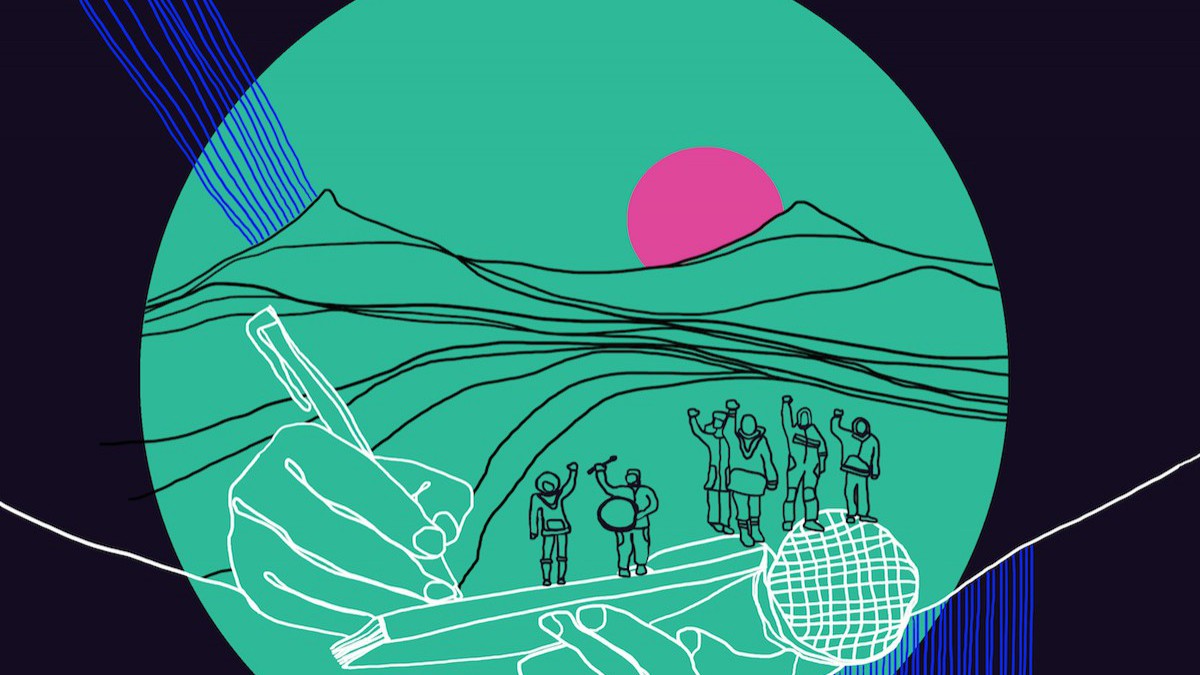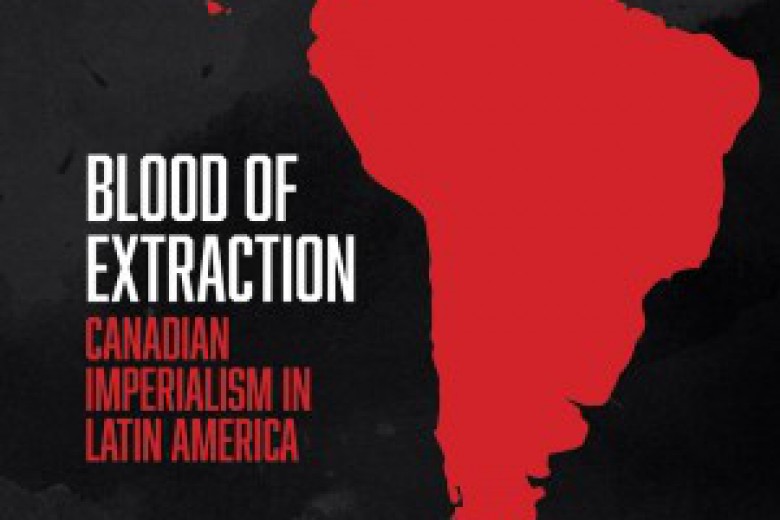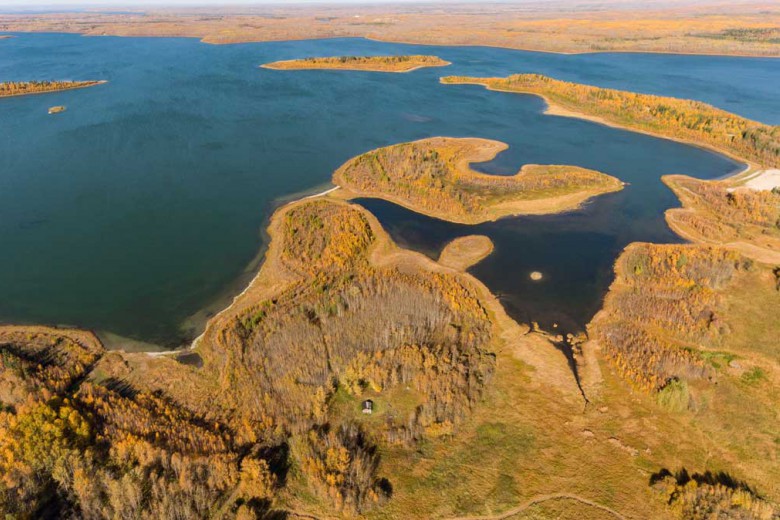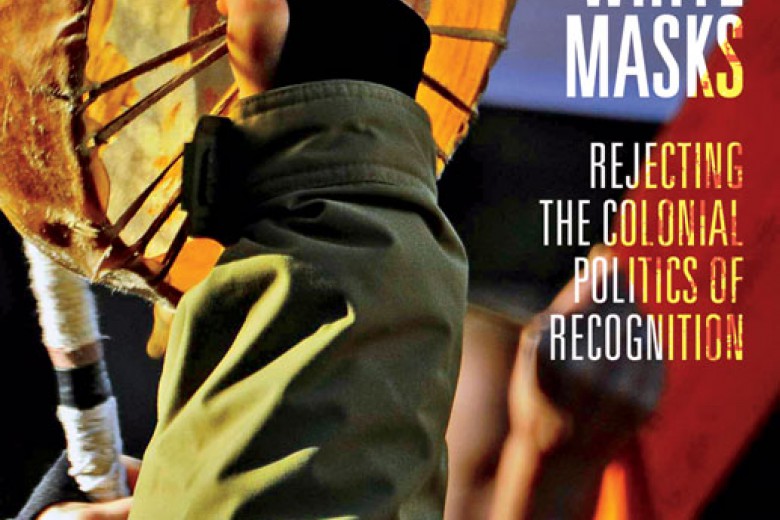The heavy hand of the state was coming down. The Supreme Court had granted an injunction with my name on it – alongside the names of about 20 land protectors. Armed police were standing by to enforce it. Four days into the Innu- and Inuit-led occupation of the Muskrat Falls hydro project site in 2016, and with tens of thousands of people watching my live reports, I was forced to choose between being arrested and losing the story. After hours of deliberation, I told the land protectors I was leaving.
In a final round of interviews, some of them shared optimistic words about what they had achieved during the occupation. But their faces and the tone of their voices told another story: of sadness, defeat, and vulnerability. The land protectors held hands in ceremony and prayed: for their communities, for their own safety, for their children’s and grandchildren’s futures, and for me. I live-streamed their farewell to me on Facebook and then signed off for the last time.
Standing a short distance from the man camp in the darkness of night, I sighed and watched my breath dissipate into the air as a sense of utter defeat set in. That feeling haunts me to this day, as does the guilt of leaving Muskrat Falls at the precise moment when land protectors brought a multi-billion dollar project to a halt in a momentous challenge to colonial state power.
When the journalism industry is built on a foundation of white supremacy, publications and reporters become unwilling – maybe even unable – to acknowledge their biases and the ways their work upholds colonialism.
The criminalization of Indigenous land defence – and of the journalism that reported on it – forced me and the land protectors through years of court hearings. In the end, the dam was built and Innu and Inuit living downstream now suffer the consequences of the violence inflicted upon their river and their ways of life.
Some talked about the occupation’s silver linings: Innu, Inuit, and settler Labradorians “know now that they need to stick together to be heard and to be strong,” Innu land defender David Nuke told APTN in 2018. A 2019 decision from the Court of Appeal of Newfoundland and Labrador in my case recognized the special role journalists play when they cover Indigenous land defence. When granting an injunction, the judges wrote, courts must be careful not to infringe on Canadians’ constitutionally protected right to a free press.
But in the years since 2016, as I’ve watched media coverage of Wet’suwet’en, Haudenosaunee, and Secwepemc land defence, I’m not sure a lack of press freedom is the main issue hindering good reporting on Indigenous resistance. As the reckoning with racism in Canadian newsrooms over the last year shows us, when the journalism industry is built on a foundation of white supremacy, publications and reporters become unwilling – maybe even unable – to acknowledge their biases and the ways their work upholds colonialism.
Objectivity and settler colonialism
“Watch your language.”
That was the warning, written into an op-ed title, given by a daily newspaper columnist who took issue with my and other journalists’ use of the term “land protector” in our coverage of the Muskrat Falls resistance.
“Reporters should avoid such language, laden as it is with inherent subjectivity,” the columnist went on. “[T]he last thing any journalist wants is to fuel those who are perpetually coiled and ready to yell ‘Media bias!’”
The debate over the utility and legitimacy of objectivity in journalism is almost as old as the ideal itself. Objectivity “hinges on a more fundamental belief that there is a knowable world, a way of seeing that, once we set aside our own subjectivities, can be universally achieved or at least universally agreed upon,” journalist Lewis Raven Wallace writes in The View From Somewhere. Defenders of objectivity, like The Elements of Journalism authors Bill Kovach and Tom Rosenstiel, argue that “[o]bjectivity was not meant to suggest that journalists were without bias. To the contrary, precisely because journalists could never be objective, their methods had to be. In the recognition that everyone is biased, in other words, the news, like science, should flow from a process for reporting that is defensible, rigorous, and transparent.”
“That the prose may have become less ‘blatant’ however suggests that the audience has become more familiar with the genre conventions of colonial discourse. To put it another way: the nation has been built.”
But too often, objectivity is conflated with the views of those in positions of power. In Seeing Red: A History of Natives in Canadian Newspapers, Mark Cronlund Anderson and Carmen L. Robertson detail how, over the course of this country’s short history, Canadian newspapers have supported and advanced settler colonialism. Under the guise of “objective” reporting, journalists have consistently othered and stereotyped Indigenous Peoples, misrepresented them, and outright erased their histories and cultures. “The colonial stereotypes have endured in the press, even flourished,” the authors noted a decade ago. “That the prose may have become less ‘blatant’ however suggests that the audience has become more familiar with the genre conventions of colonial discourse. To put it another way: the nation has been built.”
Robert Ballantyne, a Cree-Mohawk grad student at Carleton University and former CBC and Toronto Star journalist, is researching anti-colonial reporting methods. He says objectivity “makes it difficult for journalists to confront their own work, as if they are somehow capable of transcending their own backgrounds, biases, and communities.” Armed with what Ballantyne calls a perceived “superpower of fairness,” journalists’ indoctrination in objectivity “can create an almost impossible situation to have difficult conversations and create change if someone believes they are beyond reproach.”
Tałtan journalist Candis Callison and her colleague Mary Lynn Young argue in their book Reckoning: Journalism’s Limits and Possibilities that “what journalists think happened is deeply related to who they are and where they’re coming from in broad and specific senses – and that there are multiple truths and perspectives that contribute to understanding what ‘really’ happened,” they write. Instead of pretending to be objective, they suggest journalists could be transparent about who they are and where they come from. “Recognizing individual and collective social and historical location needs to become part of the methodology for journalists in order to situate themselves, their knowledge, and expertise within a wider web of relations and entanglements.”
The land and the economy
Though non-Indigenous journalists benefit from colonization by living on stolen lands and reaping the benefits of Canada’s economy, we rarely – if ever – hear about land as anything but a resource to exploit.
Within settler colonialism, Eve Tuck and K. Wayne Yang write, “Land is what is most valuable, contested, required. This is both because the settlers make Indigenous land their new home and source of capital, and also because the disruption of Indigenous relationships to land represents a profound epistemic, ontological, cosmological violence. This violence is not temporally contained in the arrival of the settler but is reasserted each day of occupation.”
“There are dominant narratives” in journalism, explains IndigiNews managing editor Emilee Gilpin, a Michif journalist of Cree-Métis, Filipina, and settler descent. Gilpin previously worked as the National Observer’s lead on its First Nations Forward series and is committed to decolonizing journalism and the media.
“We see those stereotypes bubble through, because the fact that they’re ‘stopping progress,’ they’re stopping the economy, that doesn’t play well [with Canadians].”
She points to Canada’s economy as an example of a dominant narrative and notes few journalists ever question its nature or legitimacy when reporting on Indigenous land defence. Everything journalists report is in relation to the economy, she says, “as if that’s just the assumed reality, as if that’s the world view that we’re all working from.”
In a 2020 interview for TVO, Seeing Red author Carmen Robertson told Kanyen’kehá:ka journalist Shelby Lisk that while some journalists have improved their coverage of Indigenous land defence, there remains a “disconnect [between] what land means from a settler perspective — a possession, a way to improve economics in this country — and then the notion of land as something other than that, which is a relational or kinship tie, which many Canadians, for the most part, just can’t even fathom.”
As a result of that disconnect, Robertson says, “we see those stereotypes bubble through, because the fact that they’re ‘stopping progress,’ they’re stopping the economy, that doesn’t play well [with Canadians].”
Countering extractive journalism
When Ukwehu:we journalist Karl Dockstader embedded with Haudenosaunee land defenders at Six Nations of the Grand River last summer, he didn’t fully appreciate the significance of what he was doing.
“I’ve always seen myself as an outsider when it comes to journalism, and I never realized what an asset that was until I set up a tent at 1492 Land Back Lane,” he says, recalling the early days of the land reclamation in opposition to the construction of a new housing development on the outskirts of Caledonia, Ontario.
Dockstader and Sean Vanderklis, who co-host One Dish, One Mic on Niagara radio station Newstalk 610 CKTB, took a different approach to their reporting. “We believed we had a responsibility to follow traditional protocol before inviting land defenders on to the radio,” Dockstader says. As Indigenous journalists, he and Vanderklis are accountable to the communities they cover, Dockstader explains, which involves developing relationships and earning trust. When the pair visited the site, they played “LaGolf” – a lacrosse-golf hybrid game – with land defenders. “I sat around the fire, I jammed out a couple horn rattle tunes and water drum, traditional songs, with one of the singers there. And we just got to know the camp,” Dockstader recalls.
“How do you create more space for Indigenous people to move through the many oppressions that they face? Does media actually have a role in that?”
The pair’s newsgathering and reporting methodologies stand in stark contrast to how most journalists do their work. “The extractive approach to journalism treats facts like coal in a mine, using sources and places the way mining companies use land – as a resource to dig into, and then leave behind,” writes Wallace in The View From Somewhere. Extractive journalism “goes hand in hand with ‘objectivity’: the outside observer objectifies the people and places the stories are about, who become ‘sources’ rather than human beings.”
Courtney Skye, who is Mohawk Turtle Clan from Six Nations and a researcher, policy analyst, and consultant, has supported 1492 Land Back Lane’s efforts. She praises Dockstader and Vanderklis’ approach to covering the land defence. “They did a really professional job of reminding people of their role and their work, but at the same time they are Indigenous reporters,” she says, pointing out that the Oneida Nation, of which Dockstader is a citizen, is one of the six that comprise Six Nations of the Grand River.
“When you are in your home territory and you have familial connections and responsibilities to people, and you understand what those are – our laws, our ways of being should mean more and should supersede the expectations of colonial professionalism,” she says.
For his work, Dockstader was charged with mischief and failure to comply with a court injunction that was intended to get land defenders off the construction site. The Canadian Association of Journalists and Canadian Journalists for Free Expression immediately condemned, “in the strongest possible terms, the Ontario Provincial Police’s decision to arrest and lay charges against an award-winning Indigenous journalist.” Three and a half months later, the Crown withdrew the charges, saying there was no reasonable prospect of conviction. In its 2021 World Press Freedom Index report, Reporters Without Borders noted the ongoing criminalization of journalists who cover Indigenous land defence in its critique of Canada’s track record on press freedom.
Making power visible
Journalists covering land defence stories often report on “divisions” within communities as a way to represent the diverse ideas and perspectives Indigenous people have on issues like resource development, land stewardship, and protection of collective rights. But without historical context and an eye to power, journalists often end up supporting colonial power structures, says Hayden King, who is Anishinaabe from Beausoleil First Nation and the executive director of the Yellowhead Institute, an Indigenous-led research centre at Ryerson University. “This whole notion of factionalism can be its own narrative trope,” he explains. “If reporters had the tools to critically assess who will benefit from the story [they’re] telling, it might offer some correctives to how that story is told.”
Six Nations’ most recent chief and council – elected by less than 10 per cent of eligible voters – signed an accommodations agreement with the housing developer in 2019. However, the Haudenosaunee Confederacy Chiefs Council, which represents Six Nations’ traditional governance system, has never consented to the development and has publicly supported 1492 Land Back Lane. Skye says it’s crucial that journalists reporting on the land reclamation recognize the ways colonialism has disrupted Haudenosaunee decision-making processes. “Through the imposition of the Indian Act, certain people have been elevated into positions of power, [into] systems of hierarchies,” she explains. “It’s one of the ways that colonialism continues to hold Indigenous people back.”
“We don’t need more ‘both sides’ reporting as a matter of course. We need a reckoning with the cultural forces of white supremacy and patriarchy themselves – these animating fantasies of superiority.”
People often respond to colonial oppression by conforming to the system in order to access power, Skye says. “A lot of people see that as a way to our safety, a way to our success, and I try to always remember that and not to hold a person personally responsible for it. But you have to have that simultaneous contextualization of where people sit and the kind of access to powers that they have, which ultimately informs their opinions and their positions.”
For Wallace, simply incorporating different perspectives into a story isn’t good enough. “We don’t need more ‘both sides’ reporting as a matter of course. We need a reckoning with the cultural forces of white supremacy and patriarchy themselves – these animating fantasies of superiority,” they write. “That requires a new framework for journalism – one that doesn’t shy away from analyzing and naming power and oppression.”
Journalism as intentional and relational
Skye questions the role journalists could play when reporting on the impacts of colonialism on Indigenous communities: “How do you create more space for Indigenous people to move through the many oppressions that they face? Does media actually have a role in that? They might. Or are they just being a chronicler of the progress and the place that communities are at? Do they actually have a role in liberation?”
Movement journalism is a framework that emerged out of, and in response to, Black and migrant struggles in the southern United States. It is “journalism in service to liberation,” according to Press On, a southern U.S.-based media collective. Journalist and Press On co-founder Anna Simonton writes that movement journalism “strives to meet the needs of communities that are directly affected by injustice, and that are taking action toward liberation for all people.”
Tina Vásquez, a movement journalist and reporter for BIPOC-led news outlet Prism, explains that movement journalism sees impacted people not as sources but as collaborators. “People entrust me with sensitive stories and I have certain rules of engagement that confirm communities’ trust in me,” she writes in a Medium post, explaining that she has worked for years to build trust among people in migrant rights, reproductive justice, and racial justice movements. “I approach my work collaboratively, centering the most impacted people, and doing whatever humanly possible to reduce harm.”
But doing movement journalism isn’t easy, especially for reporters of colour and other marginalized journalists, says Vásquez. Identifying as a movement journalist means “your work will be demeaned and dismissed as ‘activism’ or ‘advocacy,’ and your ability to actually operate as a journalist may be questioned,” she writes. “The assumption being that you’re too close to stories to tell them honestly, or that you are simply the mouthpiece for movements, mindlessly reporting and never questioning.”
“Or are they just being a chronicler of the progress and the place that communities are at? Do they actually have a role in liberation?”
Wallace, who is also a co-founder of Press On, says new forms of journalism can still embrace traditional ethics and principles like “verification and fact-checking, editorial independence from political parties and corporations, clarity and transparency about financial and political conflicts of interest, and deep, thorough sourcing.” But these can be accompanied by what Wallace calls “radical transparency about both our values and our methodologies.”
Callison and Young ask in their book: “[H]ow might we begin to think anew about journalists’ relations to the lands, peoples, and societal structures they cover – and to ascertaining who speaks for whom? And is it different for Indigenous journalists?”
In their newsgathering and reporting, Dockstader and Vanderklis engaged in what Callison and Young call “systems journalism,” which regards the journalist’s own situated knowledge as “a form of expertise rather than a bias.” Systems journalism also interprets issues and events not as “one-offs, but as intersections of societal systems and structures that have histories,” the authors explain. “And this means investigating histories many weren’t taught and don’t know.”
In their report for Canadaland, Dockstader and Vanderklis placed the land reclamation in historical context and aired interviews where land defenders shared their concerns around Canadian media’s historical misrepresentation of Indigenous land defence.
“Just sharing [stories] that humanize the events [rather than] continuously sharing the same black-and-white narratives that there are protesters and there are perpetrators.”
“We’re declaring our bias, by the way,” Dockstader said. “Like, every Sunday when we go on the radio we talk about the fact that I’m a direct stakeholder; I’m Oneida of the Thames, and while that community’s separate from Six Nations people, we’re declaring it. I think that’s relevant.”
Gilpin leads a team mostly comprised of Indigenous women and non-binary journalists at IndigiNews, where intentionality is a guiding principle in their work. “Sometimes we’re not even real with ourselves about our intention, and I think it’s a practice we need to nurture in journalism,” she says. As an example, IndigiNews prioritizes stories with the goal of countering some of colonialism’s specific harms. “Indigenous people, through colonization, have been dehumanized. So in many ways I think our job as well is to humanize, to make sure we’re not repeating that,” Gilpin explains.
“What kinds of stories can we share that aren’t just those racy divisive stories?” she asks, on the issue of land defence. “What about stories of the actual land in question? What trees are these trees? Who are these trees? Who has relationships with these trees? How far does that relationship stretch back? What medicines are at risk?” she continues.
“Just sharing [stories] that humanize the events [rather than] continuously sharing the same black-and-white narratives that there are protesters and there are perpetrators. Because that’s only a fraction of what’s happening. And we are continuing to miseducate mass populations and that has consequences, on some folks more than others.”
Disrupting settler colonialism
Dockstader doesn’t believe journalism can be decolonized because it is “built on a foundation of white supremacy.”
Ballantyne suggests journalism is limited by its environment: “Journalism was a practice established within the settler colonial state, so that is its boundary.” But if employed appropriately within those boundaries, he adds, it can be a force for foundational change and a pathway to radically different kinds of Indigenous journalisms. “Decolonization and anti-colonial reporting approaches can only disrupt or slow the settler colonialism structure,” he says. In the absence of other established forms of journalistic storytelling, Ballantyne says embracing anti-colonial reporting methods “is an essential process to get journalists and audiences to imagine a form of journalism outside of that structure.”
Ballantyne cites Cree journalist Connie Walker’s latest podcast series as an example of the powerful anti-colonial journalism that only an Indigenous journalist could do. In Stolen: The Search for Jermain for Gimlet Media, Walker “situates herself early on about how racism has affected her life and how it connects her to her investigating missing and murdered Indigenous women,” he says. “Later in the series, she shares how domestic violence in her family traumatized her, and as she explores Jermain Charlo’s abuse and her disappearance, it becomes a uniquely Indigenous conversation about the effects of colonialism, internalized racism, and why there’s violence in our own communities.”
Conversely, while non-Indigenous reporters who go into Indigenous communities may “seem noble,” Ballantyne continues, “they’re also taking bylines, they’re also taking salaries. They’re also mining Indigenous views and people for their storytelling. How do you reconcile the desire to create change with getting advancements through this kind of storytelling? Non-Indigenous journalists can’t participate in systems that continue to harm Indigenous people and then reinvent themselves as saviours.” Even well-intentioned non-Indigenous journalists typically see the world and frame their stories through the “gaze of the colonizer,” Ballantyne says. “It’s always, ‘Look at you, look at your poverty, look at what we’ve done to you.’ The colonizer’s mirror is never back on itself.”
“Journalism was a practice established within the settler colonial state, so that is its boundary.” But if employed appropriately within those boundaries, he adds, it can be a force for foundational change and a pathway to radically different kinds of Indigenous journalisms.
To recognize that gaze and its role in extractive journalism, Ballantyne says we “need only look back on issues that have been continually reported on but haven’t changed. There is a continual cycle of situating the problem over and over again and not being just as relentless about the follow-up.”
Ballantyne says non-Indigenous journalists should not stop reporting on Indigenous-related issues – they just have a distinct role to play. In addition to “holding ground for Indigenous journalists, for Indigenous communities to tell their own stories on their platforms,” they must turn the colonizer’s gaze back on to themselves and “consider how the issues they’re reporting on are about the failures of Canadian systems, and take a look at themselves and their work within those systems,” he says.
“Unless you’re constantly in a state of resistance and questioning, you’re upholding the systems that continue to oppress. In the same way that if you’re not challenging colonialism every day and every time you can, then you’re upholding it,” Ballantyne continues. “Of course that’s an impossible state of being, to constantly feel like you’re oppressing. But that is kind of the state of our world, isn’t it? We’re in a time of change and questioning.”





_780_520_s_c1.png)

